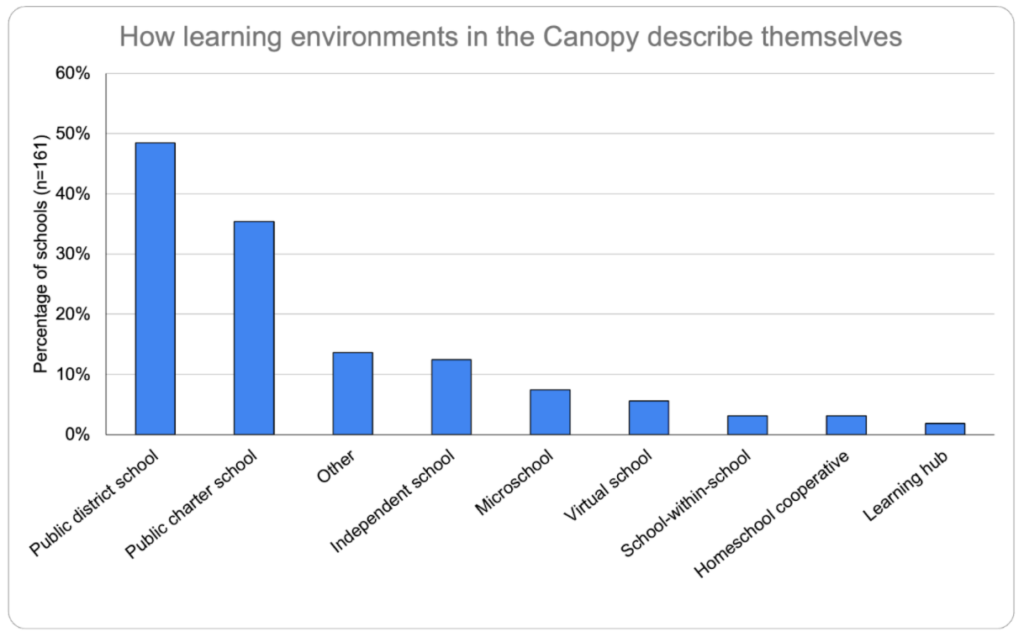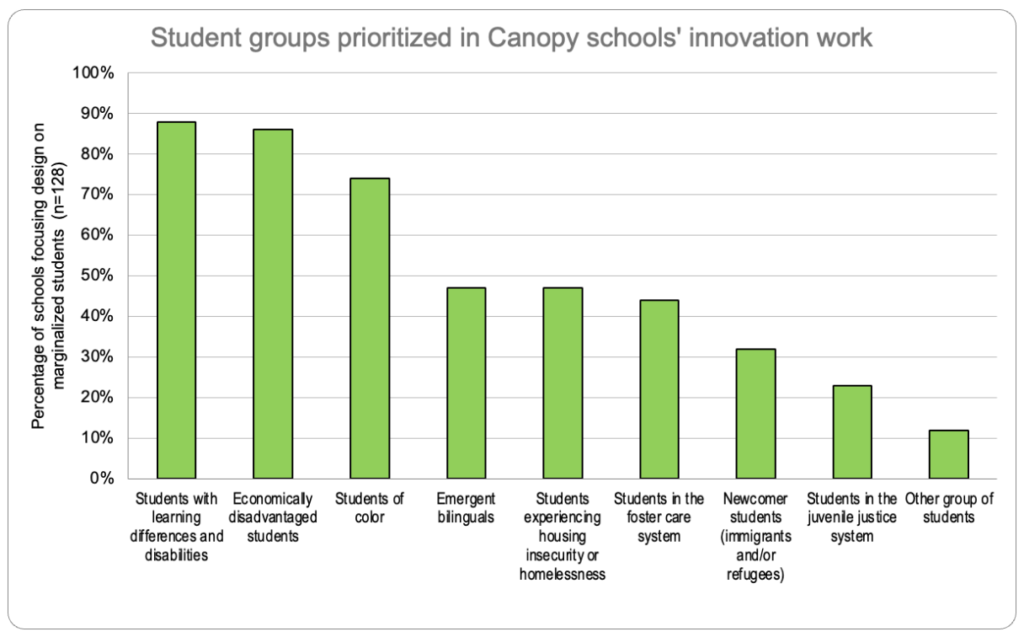This piece originally appeared in The 74.
Encouraging innovation in schools right now can feel sorely out of touch with educators’ current realities. As I heard a school leader say in a focus group last fall, pushing for innovation is like “trying to remodel your kitchen when your living room is on fire.”
But new data suggests that some schools are finding ways to innovate nonetheless — and focusing their work on essential problems of educational equity.
The Canopy project, a collaborative effort to surface and share a diverse set of innovative learning environments, is releasing an updated dataset to help shed light on the practices and priorities of innovative learning communities. The data is free to access, and project organizers plan to release in-depth analysis in the coming months.
An early look at the data made one thing clear: One urgent reason schools are innovating is to design solutions to the problems most often faced by marginalized students and families. Through approaches like culturally affirming environments and equitable access to real-world learning opportunities, these schools show that innovation isn’t all about flashy initiatives — it’s about designing a more equitable system.
Since 2018, the Canopy project has set out to capture the diversity of K-12 learning environments challenging old assumptions about “school.” First, the project invites hundreds of education-focused organizations to nominate schools that they believe deserve greater recognition for designing equitable and student-centered learning environments. Next, nominated schools are invited to share more about the “what” and “why” of their innovations through a 20-minute survey. Because the purpose of the project is to illustrate trends and patterns in school practice, schools aren’t formally evaluated before being included.
Originally launched by the Christensen Institute and now led by the Center on Reinventing Public Education and Transcend, the project recently updated its interactive portal to feature new data from 161 schools whose leaders recently participated in the Canopy survey.

Historically, schools in the Canopy project come from a wide variety of geographies and contexts for K-12 innovation, and this year’s dataset is no different. About half of the 161 included in the new survey are traditional district schools, while 35% are charters and 12% are independent (private) schools. Smaller percentages call themselves microschools (7%), virtual schools (6%) or homeschooling cooperatives (3%). A quarter of schools are led by leaders of color, and 60% by women. Schools are located in 40 states; Washington, D.C.; and Puerto Rico.
Among the participating schools in the survey, four-fifths reported designing their learning environments to meet the needs of students who have been marginalized. Of those, most say their designs focus specifically on children with learning differences and disabilities, economically disadvantaged students and children of color.

What does it mean to center marginalized students in school design? A report from the Canopy project will share more in-depth analysis in the coming months, but the schools’ profiles offer some clues.
For instance, one approach cited by 76% of Canopy respondents involves designing learning environments that honor and connect to students’ cultural backgrounds. For example, Oceti Sakowin Educational Learning Center, in Rapid City, South Dakota, is a microschool — supporting just six students — designed to be “Indigenous learner centered,” according to its co-leaders. The microschool seeks to “cultivate and strengthen learners’ cultural identities by validating Lakota knowledge, using Lakota thought and philosophy as the reference point.” School leaders report their approach is sensitive to trauma that students may have experienced, and instruction relates their learning to the land and community around them.
Another common approach, also reported by the vast majority of Canopy schools, is to help students learn through real-world experiences. While this is by no means new, it’s often perceived as a privilege reserved for students who express interest or show aptitude. However, schools focused on innovation for equity provide these experiences to students who don’t often get access to them. Chautauqua School, a charter in Panama City, Florida, designs “service learning” experiences specifically for students with disabilities and learning differences. Students participate in both local and international trips (fully funded by the school) where they develop skills and knowledge through helping other communities. With 48 students enrolled, the school says it aims to develop students’ social consciousness and action, driving home its motto that people with disabilities are “the servers, not the served.”
At Cañon City High School, a comprehensive high school in Colorado, students are mentored by neighborhood partners, complete internships in the community and earn college credits while still in high school. The school exposes students to career options beginning in ninth grade and helps each student identify career goals and a pathway to achieve them. The school’s Canopy profile describes pairing academic and career opportunities with “preventative and proactive” social-emotional learning supports to ensure that every student graduates prepared for a viable next step after high school. Principal Bill Summers was recently named Colorado’s High School Principal of the Year, and during his six years at the school, graduation rates have risen from 73% to 89%.
The moment could not be more urgent for directing innovation efforts toward solutions that reflect a radical commitment to equity. Instead of flocking to support initiatives because they’re flashy and new, education leaders and policymakers should focus on how innovative ideas advance equity. As a coalition of education leaders of color recently wrote, “Innovation must be defined by how a solution … recognizes, reflects and rewards the vibrant dimensions of a child” — especially students whom the traditional system has historically underserved.
This year’s Canopy data suggest that some schools are actively seeking out these solutions. Going forward, CRPE and Transcend will continue to work with Canopy project collaborators to make sense of how schools are doing so, including in-depth research on select approaches that are achieving results.




